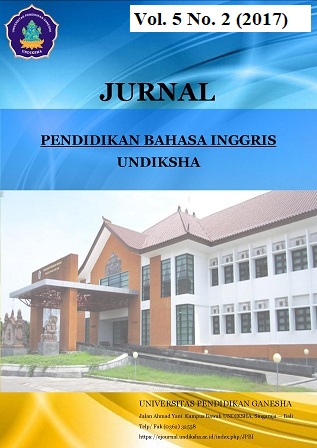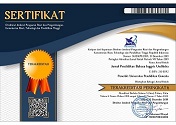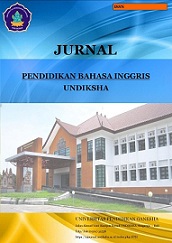An Analysis of Translation Strategies in the Short Story Entitled In Twilight Born by John H. McGlynn
DOI:
https://doi.org/10.23887/jpbi.v5i2.16994Abstract
Penelitian ini ditujukan untuk menganalisis strategi terjemahan yang sering dan jarang digunakan dalam cerita pendek yang berjudul In Twilight Born oleh John. H. McGlynn. Penelitian ini termasuk dalam penelitian kualitatif dengan menggunakan checklist dan rubrik sebagai instrumen. Hasil dari penelitian ini menunjukkan translation by paraphrase using unrelated word sebagai strategi yang paling sering digunakan dan Translation using loan word or loan word plus explanation sebagai strategi yang paling jarang digunakan. Terdapat 11 kata yang termasuk strategi translation by paraphrase using unrelated word dan 4 kata termasuk strategi translation using a loan word or loan word plus explanation. Selain itu, kualitas terjemahan yang dimiliki dalam cerita pendek yaitu akurat, berterima, dan mudah dibaca. Dalam aspek keakuratan, ditemukan data sebanyak 254 kalimat yang termasuk sebagai terjemahan akurat, 47 kalimat termasuk terjemahan kurang akurat, dan 1 kalimat termasuk terjemahan tidak akurat. Dalam aspek keberterimaan, ditemukan sebanyak 272 kalimat yang termasuk sebagai terjemahan berterima, 30 kalimat termasuk terjemahan kurang berterima, dan 1 kalimat termasuk terjemahan tidak berterima. Dalam aspek keterbacaan, ditemukan sebanyak 279 kalimat yang termasuk sebagai terjemahan terbaca, 14 kalimat termasuk terjemahan kurang terbaca, dan 0 kalimat termasuk terjemahan tidak terbaca. Dengan demikian, penelitian ini bermanfaat untuk para penerjemah dapat memberikan hasil terjemahan yang lebih baik melalui penggunaan strategi dalam menerjemahkan teks dan meningkatkan kualitas terjemahan. Selanjutnya, peneliti lain diharapkan bisa menggunakan jenis strategi lain dan teks yang berbeda.Kata Kunci : terjemahan, strategi terjemahan, kualitas terjemahan, cerita pendek
This study was aimed at analyzing translation strategies in the short story entitled In Twilight Born by John H. McGlynn. This study is qualitative research that used checklist and rubric as the instruments. It was found that translation by paraphrase using unrelated word as a strategy that mostly used and the translation using loan word or loan word plus explanation as a strategy that rarely used. There were 11 words in translation by paraphrase using unrelated word and 4 words in translation using a loan word or loan word plus explanation. Moreover, the quality of short story translation was accurate, acceptable, and readable. In accuracy aspect, there were 254 sentences categorized as an accurate translation, 47 sentences as less accurate translation, and 1 sentence as an inaccurate translation. In acceptable aspect, there were 272 sentences categorized as an acceptable translation, 30 sentences as less acceptable translation, and 1 sentence as an inacceptable translation. In readability aspect, there were 279 sentences categorized as a high readability, 14 sentences as a medium readability, and 0 sentence as a low readability. Thus, it is beneficial for other translators to conduct better translation result by applying the strategies and improving the quality of translation as well as it is as the reflection for the other researchers to apply other strategies and use other text sources.
keyword : translation, translation strategy, quality of translation, short story
Published
2019-02-28
Issue
Section
Articles
License
Authors who publish with the Jurnal Pendidikan Bahasa Inggris Undiksha agree to the following terms:- Authors retain copyright and grant the journal the right of first publication with the work simultaneously licensed under a Creative Commons Attribution License (CC BY-SA 4.0) that allows others to share the work with an acknowledgment of the work's authorship and initial publication in this journal
- Authors are able to enter into separate, additional contractual arrangements for the non-exclusive distribution of the journal's published version of the work (e.g., post it to an institutional repository or publish it in a book), with an acknowledgment of its initial publication in this journal.
- Authors are permitted and encouraged to post their work online (e.g., in institutional repositories or on their website) prior to and during the submission process, as it can lead to productive exchanges, as well as earlier and greater citation of published work. (See The Effect of Open Access)













